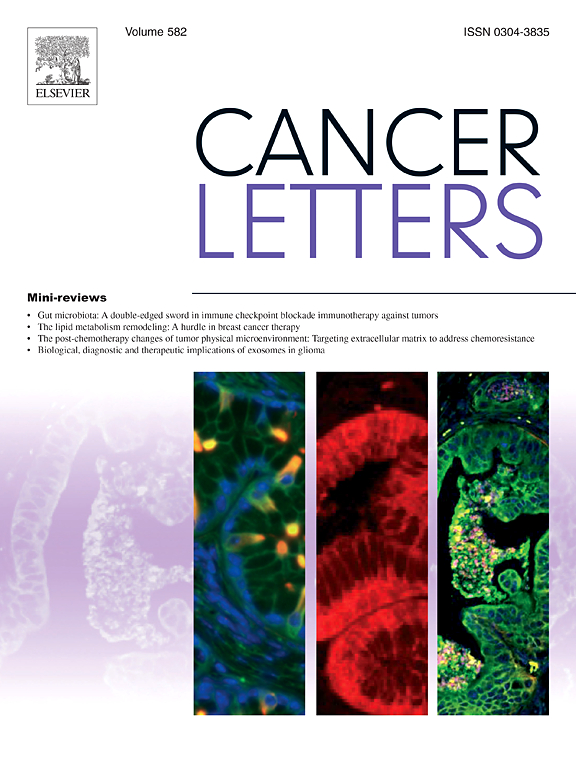Extracellular vesicle proteomics identify neutrophils as potential mediators of bladder radiotoxicity in prostate cancer
IF 9.1
1区 医学
Q1 ONCOLOGY
引用次数: 0
Abstract
Radiation cystitis (RC) is a chronic debilitating complication that impacts 8–11% of patients with prostate cancer (PCa) after radiotherapy (RT), reducing quality of life and contributing to decisional regret. Reliable treatments to alleviate the symptoms of RC, which include gross hematuria, are lacking, emphasizing the need for predictive biomarkers of RC to support therapeutic decision-making. We performed paired liquid chromatography-tandem mass spectrometry (LC-MS/MS) analyses of the protein cargos in extracellular vesicles (EVs) from the urine of PCa patients who did or did not develop late hematuria following standard-of-care RT. We identified a 60-protein RT-toxicity-associated signature enriched for neutrophil-related proteins, several of which, including myeloperoxidase (MPO), were elevated even before RT in urinary EVs from patients who later developed hematuria. In healthy mice, focal bladder irradiation was sufficient to elicit a localized neutrophil response in the bladder, while in vitro co-culture assays confirmed the ability of neutrophils to induce urothelial cell killing following irradiation, a process that was abrogated by the CRISPR/Cas9-mediated deletion of MPO or the EV release regulator Rab27α. Serum EV proteomics from these same patients further validated the neutrophil-related RC risk signature, and enzyme-linked immunosorbent assays (ELISAs) gave additional support to MPO and other neutrophil-related proteins, including defensin α3 (DEFA3) and neutrophil elastase (ELANE), as possible predictors of late hematuria development following RT in a larger cohort of PCa patients. Neutrophils may thus at least partially mediate bladder radiotoxicity in PCa patients. The multi-protein risk signatures and specific biomarkers identified herein may provide an opportunity for risk stratification in PCa.
细胞外囊泡蛋白质组学鉴定中性粒细胞作为前列腺癌膀胱放射毒性的潜在介质。
放射性膀胱炎(RC)是一种慢性衰弱性并发症,影响8-11%的前列腺癌(PCa)放疗后患者,降低生活质量并导致决策后悔。目前还缺乏减轻RC症状(包括血尿)的可靠治疗方法,因此需要RC的预测性生物标志物来支持治疗决策。我们对标准治疗后发生或未发生晚期血尿的PCa患者尿液中的细胞外囊泡(ev)中的蛋白质进行了配对LC-MS/MS分析。我们发现了一种富含中性粒细胞相关蛋白的60蛋白RT毒性相关特征,其中一些蛋白,包括髓过氧化物酶(MPO),甚至在RT之前在后来发生血尿的患者尿液ev中升高。在健康小鼠中,局部膀胱照射足以引起膀胱中局部中性粒细胞反应,而体外共培养实验证实了中性粒细胞在照射后诱导尿路上皮细胞杀伤的能力,这一过程被CRISPR/ cas9介导的MPO或EV释放调节因子Rab27α的缺失所消除。来自这些患者的血清EV蛋白质组学进一步验证了中性粒细胞相关的RC风险特征,ELISAs进一步支持MPO和其他中性粒细胞相关蛋白,包括防御素α3 (DEFA3)和中性粒细胞弹性蛋白酶(ELANE),在更大的PCa患者队列中,作为RT后晚期血尿发展的可能预测因素。因此,中性粒细胞可能至少部分介导前列腺癌患者的膀胱放射毒性。本文确定的多蛋白风险信号和特定生物标志物可能为前列腺癌的风险分层提供机会。
本文章由计算机程序翻译,如有差异,请以英文原文为准。
求助全文
约1分钟内获得全文
求助全文
来源期刊

Cancer letters
医学-肿瘤学
CiteScore
17.70
自引率
2.10%
发文量
427
审稿时长
15 days
期刊介绍:
Cancer Letters is a reputable international journal that serves as a platform for significant and original contributions in cancer research. The journal welcomes both full-length articles and Mini Reviews in the wide-ranging field of basic and translational oncology. Furthermore, it frequently presents Special Issues that shed light on current and topical areas in cancer research.
Cancer Letters is highly interested in various fundamental aspects that can cater to a diverse readership. These areas include the molecular genetics and cell biology of cancer, radiation biology, molecular pathology, hormones and cancer, viral oncology, metastasis, and chemoprevention. The journal actively focuses on experimental therapeutics, particularly the advancement of targeted therapies for personalized cancer medicine, such as metronomic chemotherapy.
By publishing groundbreaking research and promoting advancements in cancer treatments, Cancer Letters aims to actively contribute to the fight against cancer and the improvement of patient outcomes.
 求助内容:
求助内容: 应助结果提醒方式:
应助结果提醒方式:


